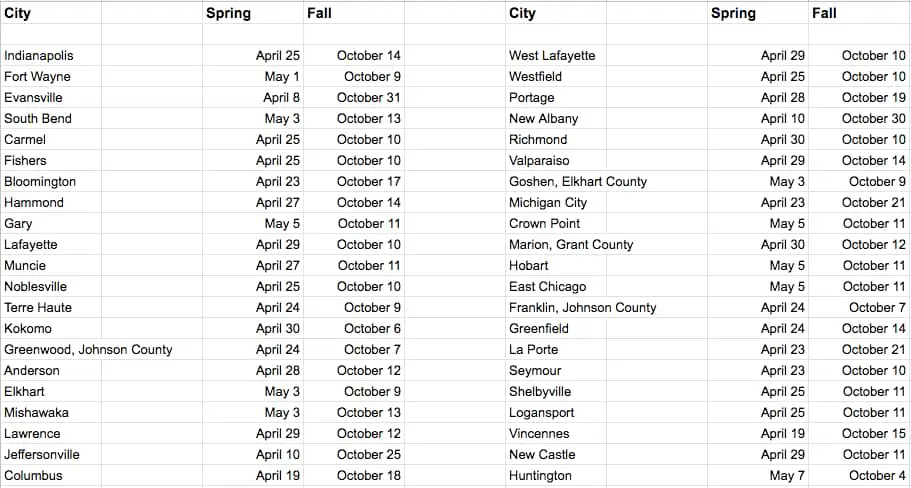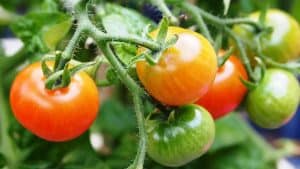When can I plant tomatoes in Indiana?
When to Plant Tomatoes in Indiana – Gardening can pose quite a challenge in the Hoosier state because of the weather’s unpredictability. At the southern tip of Indiana, we have U.S. Department of Agriculture Plant Hardiness Zone 6b while in most of the northern half of the state it’s Zone 5b.
Given this, the final frosts throughout Indiana range between the second week in April through to the second week in May.
For more exacting dates where you are, check the table below. The table lists approximate first and last frost dates for various cities in Indiana. Note that the dates provide a probability of 30 percent. Frost dates are averaged from 30 years of data (1981-2010).
Last and First Frost Dates Indiana

Tap the chart to enlarge
If you’re growing your tomatoes from seed, whether they are Black Russian tomatoes, the Campari tomato, Roma tomatoes, Dixie Red tomato, Oxheart tomato, or whichever hybrid or cultivar you are interested in, plant them six to eight weeks prior to the final frost date for your area. Seeds are best planted indoors to protect from frost while transplants (seedlings that you’ve purchased) are best planted outdoors once the final frosts have passed.
When to Plant Tomatoes in Indiana – Seeds or Transplants?
If you prefer to grow your tomatoes from seed, plant them in small pots suited to seeds such as these biodegradable peat Jiffy pots:
Biodegradeable and Organic Seed Starter Peat Pots
Plant seeds around six or eight weeks prior to the predicted final frost date. As the seeds turn into seedlings thin them and leave only the sturdier ones.
If you purchase seedlings/ transplants select the ones that are relatively thick in the stem. Pencil thickness is ideal. Any seedlings that are yellowing or leggy should be avoided.
Remove any flowers. Fruit will be unable to set at this stage due to low night temperatures (anything below 55 degrees F at night and fruit will be unable to set).

What are the Best Tomato Cultivars for Indiana?
Even though the weather in Indiana is very changeable that’s not to say tomatoes have a hard time here. Indeed, almost any tomato variety can do well inclusive of indeterminate varieties (larger, stronger growing plants), determinate varieties (smaller varieties than indeterminate), and varieties that have smaller-sized fruit such as plum tomatoes, cherry tomatoes, and grape tomatoes.
Read: What’s the difference between determinate and indeterminate tomatoes?
There are a few heirloom varieties that will do well in Indiana. Among them are Cherokee Purple, Rose, Brandywine, and Martha Washington.
Wilt diseases tend to be quite a problem in the state of Indiana. If wilt has been a problem for your tomatoes or any other plants it’s wise to select wilt resistant tomato cultivars. These cultivars have been designated with ‘F’ (Fusarium wilt) and ‘V’ (Verticillium wilt). You’ll find the designation on the label.
Some wilt resistance is offered by various tomato cultivars such as Health Kick, Early Girl, and Beefmaster.
When to Plant Tomatoes in Indiana – Climatic Considerations
Once the temperatures start to warm tomatoes tend to do very well in Indiana. Once nighttime temperatures rise above (and stay above 45 F) you can plant your transplants outside.
In northern Indiana, this will usually occur around mid May. In southern Indiana, nighttime temperatures will remain above 45 F typically from mid April onward. In central Indiana because of the variation in microclimates timing is a little more tricky to predict. In general, the timing would be around end of April in central Indiana.
Transplanting Tomatoes into the Garden
Your tomatoes will benefit from copious sunshine. Try to find a spot in your garden that affords at least six hours of full sunshine each day.
Tomatoes also like fertile, well-drained soil. They don’t like to have their roots sitting in water. At the same time, they do like to be well-watered.
A native tree in Indiana, the black walnut, is commonplace. Don’t plant your tomatoes anywhere close to black walnut trees. Instead, if you do have black walnut trees in your garden, plant your tomatoes well away from the tree canopy. This way the tomato plants will not have to compete for water.
If you’re growing determinate tomato plants you can space your tomatoes around 18 to 24 inches apart within rows. Between rows, the spacing should be approximately three feet. This allows plenty of space for hand watering.
For indeterminate tomato varieties (more vigorous than determinate varieties) plant at least 24 inches apart within rows and three to four feet between rows.
If there’s not enough rain (at least one inch per week) water your tomatoes thoroughly.


